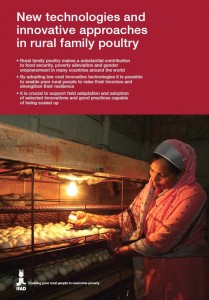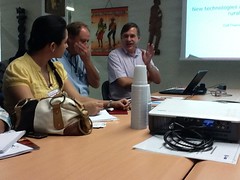 One of my jobs a few weeks ago was to facilitate sessions at the Rome Share Fair. This included making sure there was some sort of blog post or notes from each session. Well, I fell behind after one session. I got my blog post up on the Graphic Facilitation workshop, and convinced Sophie Alvarez to blog about the Communities of Practice Clinic Etienne and I did, but then there were FOUR more! Mamma mia. Here is one… from the session on New Technologies and Innovative Approaches in Rural Family Poultry. (Slides below)
One of my jobs a few weeks ago was to facilitate sessions at the Rome Share Fair. This included making sure there was some sort of blog post or notes from each session. Well, I fell behind after one session. I got my blog post up on the Graphic Facilitation workshop, and convinced Sophie Alvarez to blog about the Communities of Practice Clinic Etienne and I did, but then there were FOUR more! Mamma mia. Here is one… from the session on New Technologies and Innovative Approaches in Rural Family Poultry. (Slides below)
Antonio Rota (IFAD) and Olaf Thieme (FAO) have been working on an approach to small scale poultry farming in rural areas that offers a glimpse into the factors that help farmers succeed in putting food on their table and making living for their families. We joked that this session could have been called “how to make a development project that works” or, riffing off of Rob Burnet’s talk on Tuesday where he talked about an attention getting technique they used, the “Chicken of Change!” (Graphic recording I did of Rob’s talk is here.)
First, a bit about the session. We kicked things off with a human spectrogram (http://www.kstoolkit.org/Human+Spectrogram) to learn more about the 20 people who came to the session. The group was diverse; some with a lot of experience with poultry and others with less experience but plenty of interest.
 While there may be more interest in the stars of livestock, cows, I’ve learned that it is poultry, goats and other small animals that are accessible to the very poor and very rural. Chickens can produce eggs and meat for high nutrition, and selling eggs and chickens brings in income. These little chicks offer financial empowerment for women. But poultry just isn’t on the radar screen and there are not many statistics to help shine a light on chickens and ducks for development. Poultry production can contribute to the MDGs around poverty, hunger, education, gender empowerment, health, and even reduction in HIV/AIDS. Super chickens!
While there may be more interest in the stars of livestock, cows, I’ve learned that it is poultry, goats and other small animals that are accessible to the very poor and very rural. Chickens can produce eggs and meat for high nutrition, and selling eggs and chickens brings in income. These little chicks offer financial empowerment for women. But poultry just isn’t on the radar screen and there are not many statistics to help shine a light on chickens and ducks for development. Poultry production can contribute to the MDGs around poverty, hunger, education, gender empowerment, health, and even reduction in HIV/AIDS. Super chickens!
I realized as I listened there is a ton of common sense in our work, but what matters is listening and acting on that common sense.
Antonio and Olaf shared a story about a village poultry project that, while scientifically sound, ran into some practical problems, like the challenge of finding high volumes of local varieties of chickens well suited to a free-ranging lifestyle, and reasonable ways to get eggs hatched. (Just a side note: in our preparation, Antonio mentioned that some people talked about “free ranging” chickens as “scavenging livestock.” Hm, interesting how language might shape our perceptions, eh?)
I was amazed how fascinating all the elements were as Antonio and Olaf told engaging stories. There were issues of vaccine distribution for Newcastle disease. Access to vaccines varies by distance from cities and the creation of vaccine networks is critical.. Poultry raising practices in general vary by distance from cities, with more intense production in peri urban and urban settings where there are more resources and capital. In the very rural areas, women have to make due with what they find locally. And all these things need to mesh with local customs and practices. So is the big pattern emerging? Yes, context! Local knowledge and adaptation matter.
Innovation does not have to mean rocket science. 90-95% of poultry loss is from disease and then second greatest loss is predators, including humans. Villagers developed a simple basket cage to protect their chicks out a wide varieties of material. Breed choices focus on runners who can evade predators and forage in the rural areas, not a slow broiler. In the cities, you can build hen houses for more intense production.
To grow more chickens you need more birds. Brood hens only work for small production. So villagers have created simple incubators that can be built in remote locations. Think about it. If you are targeting 10,000 women with 10 hens each…where do you find 100,000 local breed chickens? Large scale breeders offer “Ferrari” birds that require a lot of feed. Then woman have to decide, “feed the birds or feed my children?” These past dilemmas have caused evaluators to say “Chickens don’t work.” But they can.
Oil lamp incubators were developed by women in Bangladesh. This and related methods are adaptable to different contexts informed by the women’s’ experiences. For example, in the past, telling women to turn the eggs every hour, around the clock was downright impractical. Sponsors provided a lot of training, but people abandoned the work after training. One woman however was successful, but not willing to turn the eggs every hour. She turned twice a day and still the eggs hatched successfully. Voila! Local adaptation.
The training was also adapted, moving from two full sequential days, to 28 days of working with the women in doing the work, solving the little problems. This reflected the hatching cycle. This is where the idea of the buffer zone of sand for the oil lamp hatchery was identified and which greatly increased success. Now new village industry is building on local breeds with locally done genetic improvement through cross breeding for village conditions. This is an important remote option of poultry breeds for the poor, rural farmers and populations.
Few institutions are focusing on poultry. There apparently is little focused research. No one is doing extensive training. So we need more networking for exchange of information on poultry production. And information that is locally and contextually adapted.
The days of projects with blanket design for rural poultry are finished at IFAD and FAO. From now on they will be specifically tailored around social, economic and location specific conditions. Marginal areas need local breeds, local knowledge and resources used for food security. Closer to urban and peri urban centers we can look more at market based systems.
We need to listen to farmers and local knowledge about what is possible and use a comprehensive approach, with motivation, training for success as well as technical advice.Antonio and Olaf offered a word of advice to the new player, BMGF. “If they only invest in one of the many technical factors they will fail. We have learned from our mistakes. We know we need a holistic approach. We want to share what we learned.”